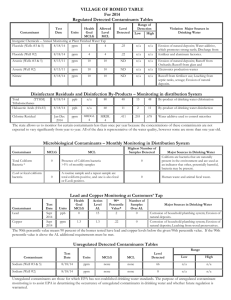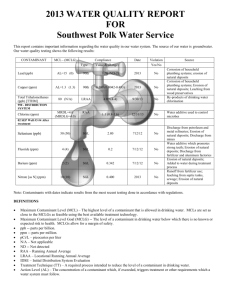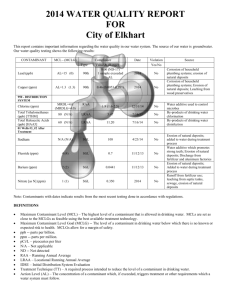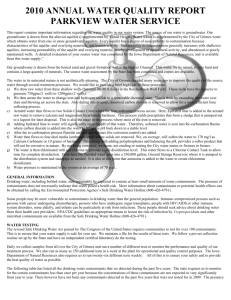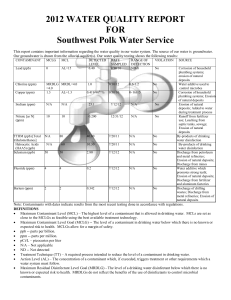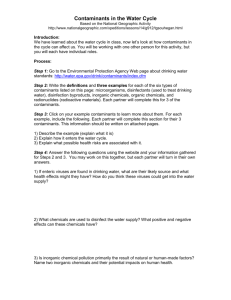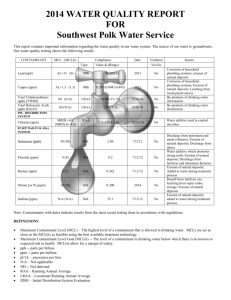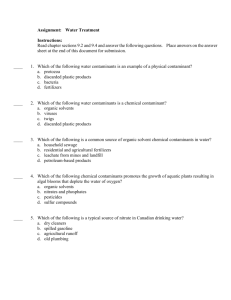Florham Park Borough – Public Water System 2014 Consumer
advertisement
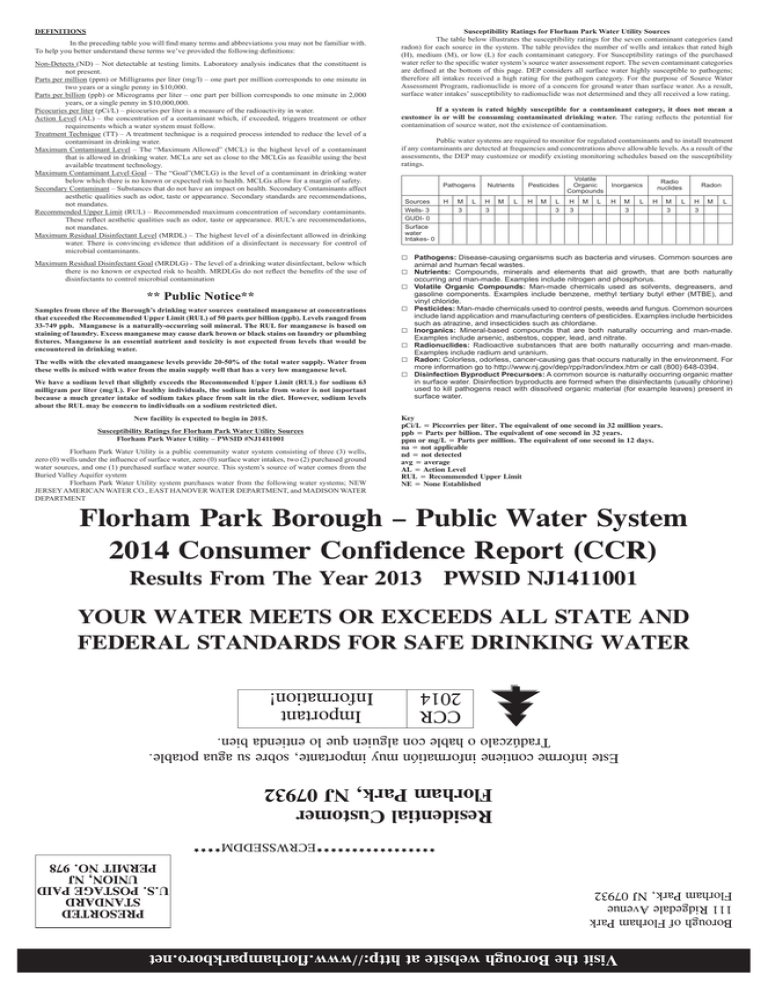
DEFINITIONS In the preceding table you will find many terms and abbreviations you may not be familiar with. To help you better understand these terms we’ve provided the following definitions: Non-Detects (ND) – Not detectable at testing limits. Laboratory analysis indicates that the constituent is not present. Parts per million (ppm) or Milligrams per liter (mg/l) – one part per million corresponds to one minute in two years or a single penny in $10,000. Parts per billion (ppb) or Micrograms per liter – one part per billion corresponds to one minute in 2,000 years, or a single penny in $10,000,000. Picocuries per liter (pCi/L) – picocuries per liter is a measure of the radioactivity in water. Action Level (AL) – the concentration of a contaminant which, if exceeded, triggers treatment or other requirements which a water system must follow. Treatment Technique (TT) – A treatment technique is a required process intended to reduce the level of a contaminant in drinking water. Maximum Contaminant Level – The “Maximum Allowed” (MCL) is the highest level of a contaminant that is allowed in drinking water. MCLs are set as close to the MCLGs as feasible using the best available treatment technology. Maximum Contaminant Level Goal – The “Goal”(MCLG) is the level of a contaminant in drinking water below which there is no known or expected risk to health. MCLGs allow for a margin of safety. Secondary Contaminant – Substances that do not have an impact on health. Secondary Contaminants affect aesthetic qualities such as odor, taste or appearance. Secondary standards are recommendations, not mandates. Recommended Upper Limit (RUL) – Recommended maximum concentration of secondary contaminants. These reflect aesthetic qualities such as odor, taste or appearance. RUL’s are recommendations, not mandates. Maximum Residual Disinfectant Level (MRDL) – The highest level of a disinfectant allowed in drinking water. There is convincing evidence that addition of a disinfectant is necessary for control of microbial contaminants. Maximum Residual Disinfectant Goal (MRDLG) - The level of a drinking water disinfectant, below which there is no known or expected risk to health. MRDLGs do not reflect the benefits of the use of disinfectants to control microbial contamination ** Public Notice** Samples from three of the Borough’s drinking water sources contained manganese at concentrations that exceeded the Recommended Upper Limit (RUL) of 50 parts per billion (ppb). Levels ranged from 33-749 ppb. Manganese is a naturally-occurring soil mineral. The RUL for manganese is based on staining of laundry. Excess manganese may cause dark brown or black stains on laundry or plumbing fixtures. Manganese is an essential nutrient and toxicity is not expected from levels that would be encountered in drinking water. The wells with the elevated manganese levels provide 20-50% of the total water supply. Water from these wells is mixed with water from the main supply well that has a very low manganese level. We have a sodium level that slightly exceeds the Recommended Upper Limit (RUL) for sodium 63 milligram per liter (mg/L). For healthy individuals, the sodium intake from water is not important because a much greater intake of sodium takes place from salt in the diet. However, sodium levels about the RUL may be concern to individuals on a sodium restricted diet. New facility is expected to begin in 2015. Susceptibility Ratings for Florham Park Water Utility Sources Florham Park Water Utility – PWSID #NJ1411001 Florham Park Water Utility is a public community water system consisting of three (3) wells, zero (0) wells under the influence of surface water, zero (0) surface water intakes, two (2) purchased ground water sources, and one (1) purchased surface water source. This system’s source of water comes from the Buried Valley Aquifer system Florham Park Water Utility system purchases water from the following water systems; NEW JERSEY AMERICAN WATER CO., EAST HANOVER WATER DEPARTMENT, and MADISON WATER DEPARTMENT Susceptibility Ratings for Florham Park Water Utility Sources The table below illustrates the susceptibility ratings for the seven contaminant categories (and radon) for each source in the system. The table provides the number of wells and intakes that rated high (H), medium (M), or low (L) for each contaminant category. For Susceptibility ratings of the purchased water refer to the specific water system’s source water assessment report. The seven contaminant categories are defined at the bottom of this page. DEP considers all surface water highly susceptible to pathogens; therefore all intakes received a high rating for the pathogen category. For the purpose of Source Water Assessment Program, radionuclide is more of a concern for ground water than surface water. As a result, surface water intakes’ susceptibility to radionuclide was not determined and they all received a low rating. If a system is rated highly susceptible for a contaminant category, it does not mean a customer is or will be consuming contaminated drinking water. The rating reflects the potential for contamination of source water, not the existence of contamination. Public water systems are required to monitor for regulated contaminants and to install treatment if any contaminants are detected at frequencies and concentrations above allowable levels. As a result of the assessments, the DEP may customize or modify existing monitoring schedules based on the susceptibility ratings. Pathogens Sources Wells- 3 GUDI- 0 Surface water Intakes- 0 □ □ □ □ □ □ □ □ H M 3 L Nutrients H 3 M L Pesticides H M L 3 Volatile Organic Compounds H 3 M L Inorganics H M 3 L Radio nuclides H M 3 L Radon H 3 M L Pathogens: Disease-causing organisms such as bacteria and viruses. Common sources are animal and human fecal wastes. Nutrients: Compounds, minerals and elements that aid growth, that are both naturally occurring and man-made. Examples include nitrogen and phosphorus. Volatile Organic Compounds: Man-made chemicals used as solvents, degreasers, and gasoline components. Examples include benzene, methyl tertiary butyl ether (MTBE), and vinyl chloride. Pesticides: Man-made chemicals used to control pests, weeds and fungus. Common sources include land application and manufacturing centers of pesticides. Examples include herbicides such as atrazine, and insecticides such as chlordane. Inorganics: Mineral-based compounds that are both naturally occurring and man-made. Examples include arsenic, asbestos, copper, lead, and nitrate. Radionuclides: Radioactive substances that are both naturally occurring and man-made. Examples include radium and uranium. Radon: Colorless, odorless, cancer-causing gas that occurs naturally in the environment. For more information go to http://www.nj.gov/dep/rpp/radon/index.htm or call (800) 648-0394. Disinfection Byproduct Precursors: A common source is naturally occurring organic matter in surface water. Disinfection byproducts are formed when the disinfectants (usually chlorine) used to kill pathogens react with dissolved organic material (for example leaves) present in surface water. Key pCi/L = Piccorries per liter. The equivalent of one second in 32 million years. ppb = Parts per billion. The equivalent of one second in 32 years. ppm or mg/L = Parts per million. The equivalent of one second in 12 days. na = not applicable nd = not detected avg = average AL = Action Level RUL = Recommended Upper Limit NE = None Established Florham Park Borough – Public Water System 2014 Consumer Confidence Report (CCR) Results From The Year 2013 PWSID NJ1411001 YOUR WATER MEETS OR EXCEEDS ALL STATE AND FEDERAL STANDARDS FOR SAFE DRINKING WATER ccR 2014 Important Information! Este informe contiene informatión muy importante, sobre su agua potable. Tradúzcalo o hable con alguien que lo entienda bien. Residential Customer Florham Park, NJ 07932 Borough of Florham Park 111 Ridgedale Avenue Florham Park, NJ 07932 EcRwssEDDM PRESORTED STANDARD U.S. POSTAGE PAID UNION, NJ PERMIT NO. 978 Visit the Borough website at http://www.florhamparkboro.net Florham Park Borough – Public Water System – 2014 Consumer Confidence Report (CCR) Results from the Year 2013 PwsID NJ1411001 YOUR wATER MEETs OR EXcEEDs ALL sTATE AND FEDERAL sTANDARDs FOR sAFE DRINKING wATER Dear Customer: Significant portions of this report contain mandatory language as required by the 1996 Federal Safe Drinking Water Act Amendments. During 2013, the Florham Park water system was in compliance with all national and state primary drinking water standards. These health and safety standards are set by the United States Environmental Protection Agency (EPA) and the New Jersey Department of Environmental Protection (NJDEP). Florham Park Water Utility regularly tests our drinking water to ensure that it meets the standards. All of the results are on file with the DEP, the agency that monitors and regulates drinking water quality in our state. Both the EPA and the NJDEP require water suppliers to mail a Consumer Confidence Report (CCR) to customers on an annual basis. This CCR provides important information about your drinking water. It shows how your drinking water measured up to government standards during the Year 2013. Please read it carefully and feel free to call us at (973) 410- 5471 if you have any questions about your water or your service; or you may call the EPA Safe Drinking Water Hotline at (800) 426-4791. If you have a specific question about water as it relates to your personal health, we suggest that you contact your health care provider. Some of the water supplied did exceed a secondary drinking water standard, also known as recommended upper limit (RUL) for manganese which can cause dark brown or black stains on laundry or plumbing fixtures. Not all customers were affected by this. Notice of the manganese level is part of this annual report. An additional notice regarding the manganese exceeding limits was also reported in The Florham Park Eagle Newspaper on May 31, 2012 and is on our web-site at http://www.florhamparkboro.net Drinking water, including bottled water, may reasonably be expected to contain at least small amounts of some contaminants. The presence of contaminants does not necessarily indicate that the water poses a health risk. More information about contaminants and potential health effects can be obtained by calling the EPA Safe Drinking Water Hotline at (800) 426-4791. The New Jersey Department of Environmental Protection (NJDEP) has completed and issued the Source Water Assessment Report and Summary for this public water system. Further information on the Source Water Assessment Program can be obtained by logging onto NJDEP’s source water assessment web site at www.state.nj.us/dep/swap or by contacting NJDEP’s Bureau of Safe Drinking Water at 609-2925550. Please see attached New Jersey Source Water Assessment Report. You may also contact the Borough of Florham Park Water Utility at 973-410-5471. Bottled Water or Tap Water? Drinking water, whether it is tap water or bottled water, comes from various sources such as rivers, lakes, streams, ponds, reservoirs, springs, and wells. The Borough’s water supply comes from three wells located in the vicinity of the Municipal Complex. Groundwater in these three wells comes from the Buried Valley Aquifer System of the Central Passaic River Basin. Many public water suppliers in southeast Morris and western Essex County rely on groundwater supplied from the Buried Valley Aquifer system. The Borough of Florham Park’s Water Utility maintains approximately forty two (42) miles of water mains ranging in size from 4 inches to 16 inches in diameter. The Borough of Florham Park’s Water Utility maintains a 1,000,000 gallon water tank (standpipe) and 250,000 gallon water tank (spheroid). We have interconnections with East Hanover, Madison Borough and the New Jersey American Water Company. From time to time you may receive water from these sources through the interconnections. Conservation: Fresh clean drinking water is vital to life so there is never enough to waste. Remember a little common sense will make a big difference. It is essential for us to take water saving steps now. We encourage our customers to use water wisely even when supplies are abundant. If we don’t conserve, we are pouring water and money down the drain. The average American can drink, shower and flush between 40 and 130 gallons of water every day. You can reduce your water consumption by up to 30 percent by taking just a few simple steps. Inside your home never use your toilet as a wastebasket. Take shorter showers or take a shallow bath instead of a shower. Turn off the tap while brushing your teeth or shaving. While waiting for hot water from the tap, catch the flow in a watering can and use it for watering house or garden plants. Conservation Cont: Keep a bottle of tap water in the refrigerator instead of running the faucet for cold water, wash vegetables and fruit in a basin and use a vegetable brush to remove dirt. Run your dishwasher only when full. And remember check faucets and toilets for leaks. Leaking toilets can waste up to 200 gallons each day. When purchasing a new washer consider a high-efficiency washing machine which can save over 50% in water and energy use. Outside the home check for and repair leaks in irrigation systems. Water the lawn or garden during the coolest part of the day. Do not water on windy days. Install a moisture sensor on irrigation systems. Following these tips, you can save hundreds of gallons of water and money. Permanent Water Use Restrictions Within the Borough of Florham Park outside water usage is permanently restricted to usage on alternate days. Alternate usage restrictions allow outside water by persons or businesses having even house or box numbers on even days and those having odd house or box numbers on even days, with all outside water usage being completely banned and prohibited on the 31st day of any month. This restriction shall not apply to athletic fields and nurseries. The Risks of Lead and Copper in Drinking Water: The water in Florham Park has passed all DEP sampling requirements. As part of the DEP CCR requirements, the Borough must present a statement about the risks of lead and copper in drinking water. If present, elevated levels of lead can cause serious health problems, especially for pregnant women and young children. Lead in drinking water is primarily from materials and components associated with service lines and home plumbing. The Borough of Florham Park’s Water Utility is responsible for providing high quality drinking water, but cannot control the variety of materials used in plumbing components. When your water has been sitting for several hours, you can minimize the potential for lead exposure by flushing your tap for 30 seconds to 2 minutes before using water for drinking and cooking. If you are concerned about lead in your water, you may wish to have your water tested. Information on lead in drinking water, testing methods, and steps you can take to minimize exposure is available from the Safe Drinking Water hotline or at http:www.epa.gov/safewater/lead. Do I need to take special precautions? Some people may be more vulnerable to contaminants in drinking water than the general population. Immuno-compromised persons such as persons with cancer who are undergoing chemotherapy, persons who have undergone organ transplants, people with HIV/AIDS or other immune system disorders, some elderly, and infants can be particular at risk from infections. These people should seek advice about drinking water from their health care providers. EPA / CDC guidelines on appropriate means to lessen the risk of infections by cryptosporidium and other microbial contaminants are available from the Safe Drinking Water Hotline at (800) 426-4791. The following table lists all the drinking water contaminants that Florham Park Water Utility detected during the 2013 calendar year. The presence of these contaminants in the water does not necessarily indicate that the water poses a health risk. Unless otherwise noted, the data presented in the table is from testing done January 1 - December 31, 2013. It should be noted that due to the fact that required monitoring for some contaminants is less than once per year there may be some water quality data represented that is more than one year old. Council Meetings Meetings of the Borough’s Mayor and Council are held the third Thursday of the month at Borough Hall at 111 Ridgedale Avenue, Florham Park, NJ 07932. For more information visit the Borough website at http://www.florhamparkboro.net Once again, the Borough of Florham Park assures you that we are taking steps to ensure the safety of your drinking water supply. Should you have any questions or concerns please call the Water Utility at (973) 410-5471. The Borough of Florham Park’s goal is to provide you with drinking water that meets all federal and state standards. Water treated at the distribution wells contains a small amount of chlorine to help ensure the safety of your water; in addition, we used polyphosphate (a sequestering agent) to delay the precipitation of oxidized manganese for a few days so that the scale which may build up on the walls of the main lines is greatly reduced. Water Quality Table 2012 and 2013 Regulation Detected Contaminants Table Inorganic Contaminants - Directly related to the safety of drinking water. (Treatment Plant) Inorganic contaminants (units) Date McLG McL Highest* Results Range of Results Typical source of contaminant Barium (ppm) 4-2-12 0 2 0.041 ND-0.041 Erosion source of contaminant chloride (ppm) 4-2-12 0 250 196 83-196 Run off/Leaching from natural deposits Water Quality Table chromium (ppm) 4-2-12 0 0.1 0.009 0.006-0.009 2009 Regulated Detected Contaminants Table Erosion of natural deposits Primary Standards – Directly related to the safety of drinking water. (Treatment Plant) Iron (ppm) 4-2-12 0 0.3 0.13 ND-0.13 from natural Inorganic Contaminants Date MCL MCL Highest Range of Leaching Typical Source deposits (Units) G * Results of Contaminant Nickel (ppm) 4-2-12 0 NE 0.004 0.002-0.004 Erosion of natural Results deposits Barium (ppm) 4-6-09 2 2 0.06 0.03–0.06 Erosion of Nitrate (ppm) 7-1-13 0 10 1.40 ND-1.40 Erosion of natural natural deposits deposits and fertilizer Chromium (ppb) 4-6-09 100 100 8 7–8 Erosion usage of natural deposits sulfate (ppm) 4-2-12 0 250 69 46-69 Run off/Leaching from Nitrate (ppm) 7-6-09 10 10 1.0 0.6 – 1.0 Erosion of natural deposits natural deposit Total Dissolved solids (TDs) (ppm) 4-2-12 0 500 639 426-639 Run off/Leaching from and fertilizer natural deposits usage Total Hardness (ppm) 4-2-12 250 493 327-493 Run off/Leaching from Nitrite (ppm) 7-6-07 1 1 0.05 ND – 0.05 Erosion of natural deposits natural deposit Zinc (ppm) 4-2-12 0 5 0.026 0.019-0.026 Run off/Leaching from and fertilizer natural deposits usage Lead and Copper (Monitoring at Customer’s Tap) Lead and Copper Date MCL (Units) G AL Copper (ppm) 6/6/12 – 6/6/09 6/15/12 6/12/09 1.3 1.3 Lead (ppb) 6/6/12 6/6/09 – 6/15/12 6/12/09 0 15 90th Percenti le 0.0315 0.13 <2 Samples > AL Typical Source of Contaminant 0 Corrosion of household plumbing Corrosion of household plumbing 0 Volatile Organic Contaminants Contaminants (Treatment (Treatment Plant) Plant) Volatile Organic Contaminant contaminant (Units) Methyl-t-butyl ether (MTBE) carbon Tetrachloride (ppb) ppb MCL Highest Range ofsourceTypical Source of Date Date McLGMCL McL Results Typical of contaminant G * Results Results Contaminant 1/7/2009- 0 NA 0.5 70 0.23 ND-0.23from factories; Disinfection by7/5/13 ND-0.290 Discharge Leaching product 4/6/2009 fromgasstoragetanksandlandfills. Methyl tert-butyl ether (ppb) 1/2/13 0 0.5 ND-0.29 Gasoline additive and Disinfection by-products (Monitoring in Distribution system) tanks Source Contaminant Date MCL MCL Highest Range offuel oil Typical (Units) G * Results of Contaminant Disinfectant Residual (Distribution System) Results Disinfectant Date MRCL MCL Highest Range Typical Source HAA5 (ppb) Residual 8/24/09 NA 60 0 0 of Disinfection byDisinfectant Residual (Distribution System) (Units) G * Results of Contaminant product Disinfectant Residual Date MRCL MCL Highest Range of Typical Source Results (HAA5: dibroacetic acid, dichloroacetic acid, monobromoacetic acid, monochloroacetic acid, Added for disinfection (Units) G4 * Results of Disinfectant Contaminant 2013 1.32 0.31 − Chlorine (ppm)acid) 2009 NA 4 1.17 – trichloroacetic purposes Results 1.32 1.26 Total THM (ppb) 8/24/09 NA 80 0 0 Disinfection byChlorine (ppm) 2009 NA 4 1.17 0.31 – Disinfectant product 1.26 (THMs: bromochloromethane, bromodichloromethane, chlorodibromomethane, chloroform) Radionuclides (Treatment Plant) Contaminant Date MCL MLC Highest Range of Typical Source Unregulated Contaminants Radionuclides (Treatment Plant) (Units) G * Results of Contaminant Contaminants Date MRL Level Detected Typical Source of Contaminant Date MCL MLC Highest Typical Source Results Range of (Units) Contaminant (Units) G0 * ± Results of Contaminant Erosion of Gross Alpha – pCi/L 1-17-06 3.1 ± 0.6 15 5.5 DCPA (ppb) 2003 1 ND – 6.8 An Herbicide Results 5.5 ± 1.6 natural deposits and 4-101.6 Erosion of 3.1 ± 0.6 Gross Alpha – pCi/L 1-17-06 15 0 5.5 ± 06 5.5 ± 1.6 natural deposits and 4-101.6 Ra 226 pCI/L 1-17-06 5 0 <1 - 0.06 ± Erosion of and06 4-100.14 0.29 natural deposits Ra 226 pCI/L 1-17-06 5 0 <1 - ±0.06 Erosion of 06 0.18± and 4-100.14 0.29 natural deposits Ra 228 pCi/L 1-17-06 Erosion of 5 0 <1 - 0.03 ± ± 0.18 and06 4-10natural deposits 0.27 0.33 Ra 228 pCi/L 1-17-06 5 0 <1 - ±0.03 Erosion of 06 0.30± and 4-100.27 natural deposits Uranium ppb 1-17-06 30 0 7 5 -0.33 7 Erosion of ± 0.30 and06 4-10natural deposits Uranium ppb 1-17-06 30 0 7 5-7 Erosion of 06 and 4-10natural deposits 06 aesthetic quality of drinking water.(Treatment Plant) Secondary Standard – Related to the Secondary Contaminants Date NJ Highest Range of Typical Source of Secondary Standard – Related to the aestheticRUL* quality of drinking water.(Treatment Plant) (Units) Result ^ Results Contaminant Secondary Contaminants Date NJ Highest Range of Typical of Manganese (ppb) 4-2-12 50 749 33 – 749 NaturalSource mineral (Units) RUL* Result Results Contaminant Sodium 4-6-09 50 52 10 –- 52 mineralfrom Sodium(ppm) (ppm) 4-2-12 50 63 ^ 18 63 RunNatural off/Leaching Manganese (ppb) are based upon the 4-6-09 50sample. 522 0.02 – 522 Natural * Highest results highest single natural mineral deposits Sodium (ppm)Recommended Upper 4-6-09 50 52 10 - 52 Natural mineral ^ New Jersey Limit. * Highest results are based upon the highest single sample. ^ New Jersey Recommended Upper Drinking water, whether it isLimit. tap water or bottled water, comes from various sources such as rivers, lakes, streams, ponds, reservoirs, springs, and wells. As water travels over the surface of the land or water, whether itnaturally is tap water or bottled water, comes from various sources material. such as rivers, throughDrinking the ground, it dissolves occurring minerals and in some cases radioactive It can lakes, streams, ponds, reservoirs, springs, and wells. waterortravels over the surface of the land that or also pick up substances resulting from the presence of As animals from human activity. Contaminants through the ground, it dissolves naturally occurring minerals andcomes in some cases radioactive It can Drinking whether it is tap water or bottled water, from various sourcesmaterial. such as rivers, may be present in water, source water include: also pick up substances resultingsprings, from the ofwater animals or from activity. Contaminants that lakes, streams, ponds, reservoirs, andpresence wells. As travels overhuman the surface of the land or through may be present in source water include: the ground, it dissolves naturally occurring minerals and in some cases radioactive material. It can also pick Microbial as viruses may come from sewage up substances•resulting fromcontaminants, the presencesuch of animals or and frombacteria, human which activity. Contaminants that may be treatment plants, septic systems, agricultural livestock operations, and wildlife. present in source water include: •• Microbial bacteria, which come from sewageor Inorganic contaminants, such as viruses salts andand metals, which can may be naturally-occurring treatment plants, systems, agricultural livestock operations, wildlife. result from urbanseptic stormas water runoff, or domestic discharges, oil and • Microbial contaminants, such viruses andindustrial bacteria, which may wastewater comeand from sewage treatment • Inorganic contaminants, such as salts and metals, which can be naturally-occurring or gas projection, mining, or farming. plants, septic systems, agricultural livestock operations, and wildlife. from and urban storm water runoff, industrial oradomestic discharges, oil and • result Pesticides herbicides, which comewhich from variety ofwastewater sources such asor agriculture, • Inorganic contaminants, such as salts andmay metals, can be naturally-occurring result from gas projection, mining, or farming. urban storm water runoff, and residential uses. urban storm water runoff, industrial or domestic wastewater discharges, oil and gas projection, •• Pesticides and herbicides, which may comesynthetic from a variety of sources suchchemicals, as agriculture, Organic chemical contaminants, including and volatile organic which mining, urban or farming. storm water runoff, andprocesses residential are byproducts of industrial anduses. petroleum production, and can, also come from • Pesticides herbicides, which may come from aseptic variety of sources as chemicals, agriculture,which urban • Organic chemical including and volatile such organic gasand stations, urbancontaminants, storm water runoff, andsynthetic systems. storm runoff, and uses. are byproducts ofresidential industrialwhich processes and petroleum production, can, also come • water Radioactive contaminants can be naturally occurring or be and the result of oil andfrom gas • Organicgas chemical contaminants, including volatile organic chemicals, which stations,and urban stormactivities. water runoff, synthetic and septic and systems. production mining are •byproducts of industrial processes also of come from Radioactive contaminants whichand can petroleum be naturallyproduction, occurring orand be can, the result oil and gasgas stations, urban storm water septic systems. and mining activities. In orderproduction to ensure that tap runoff, water isand safe to drink, the EPA prescribes regulations which limit the • Radioactive contaminantsinwhich be naturally occurring be the result of oiland andDrug gas amount of certain contaminants watercan provided by public water orsystems. The Food In orderregulations to and ensure that activities. tap water to drink, the prescribes regulations which limit the Administration establish limitsisforsafe contaminants in EPA bottled water, which must provide the same production mining amount of for certain in water provided by public water systems. The Food and Drug protection publiccontaminants health. Administration regulations establish foriscontaminants inthe bottled which must provide the same In order to ensure that taplimits water safe to may drink, EPAwater, prescribes limit Drinking water which includes bottled water reasonably be expectedregulations to contain atwhich least small protection public health. the amountoffor of certain contaminants water provided by public systems. indicate The Food amounts some contaminants. The in presence of contaminants does water not necessarily thatand the Drug water Administration regulations establish limits for contaminants contaminants in bottled water, which provide the small same Drinking water which includes bottled water may reasonably be expected tomust contain least poses a health risk. More information about and potential health effects can beatobtained by protection forEnvironmental public health.Protection amounts of some contaminants. The Agency's presence Safe of contaminants doesHotline not necessarily indicate that the water calling the Drinking Water at 1-800-426-4791. poses a health risk. More information about contaminants and potential health effects can be obtained by water Protection which includes bottled mayWater reasonably expected to contain at least calling theDrinking Environmental Agency's Safe water Drinking Hotlinebe at 1-800-426-4791. small amounts of some contaminants. The presence of contaminants does not necessarily indicate that the water poses a health risk. More information about contaminants and potential health effects can be obtained by calling the Environmental Protection Agency’s Safe Drinking Water Hotline at 1-800-426-4791.
